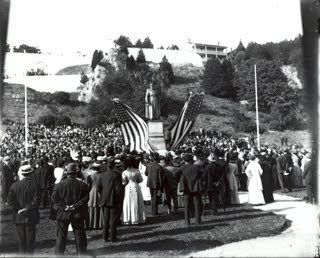
The Father Marquette statue was first dedicated on September 1, 1909 with pageantry, music, and remarks in Marquette Park on Mackinac Island. Exactly 100 years to the day later, at 7:00 p.m. on September 1, 2009, the statue was celebrated once again, marking a century of its towering presence beneath the bluffs of Fort Mackinac.
At the original dedication, a massive crowd gathered in the park, some coming from Cheboygan, Petoskey, St. Ignace, Sault Ste. Marie and Marquette. A reviewing stand was erected between the statue and the rear of the park, from which dignitaries made various speeches. The Petoskey City Band and the Grand Hotel Orchestra provided the music. Park Superintendent B. F. Emery opened the festivities by introducing Bishop Foley of Detroit who offered introductory remarks. Upon the unveiling of the statue to loud applause, U.S. Supreme Court Justice, and former Secretary of State, William R. Day, reviewed the life and heroic efforts of Marquette. The day’s festivities concluded with the singing of “America” followed by a Benediction delivered by Bishop Charles D. Williams of Detroit.

At the recent celebration, the crowds were much smaller, the speeches much shorter, but Grand Hotel's orchestra was there to play and the festivities once again concluded with the singing of "America".
No images of the seventeenth-century missionary were known to exist, so the features of the subject were speculative on the part of the artist, Gaetano Trentanove. He reportedly conferred with Father R. J. Meyer, of St. Louis, secretary of the Jesuit order, on the life of the missionary and with the head of the Jesuit order in Italy regarding the history and garb of Jesuit missionaries. Trentanove’s design presented a heroic figure. Standing and looking forward, “as if for some discovery,” with a map of the Great Lakes and upper Mississippi and compass in his right hand. The original design had him holding an open book, possibly a Bible. Some found this objectionable and it was changed, possibly because it over-emphasized missionary work instead of exploration. The left hand is shown holding the edge of his cloak and tucked at his waist is a crucifix and a rosary. Trentanove’s Marquette is bearded and appears older than the missionary, who was only 38 when he died. Such a figure contained an air of nobility that undoubtedly appealed to the Victorian sensibility.
Wisconsin Senator William Vilas later commented: “Go view the artist’s work, gaze upon the noble figure…then you shall find the ideal we would commemorate, a noble man with a soul lifted up to God, a mind inflexibly bent to duty, a heart swelling with tenderness to his fellow creatures….The man to dare without flinching, to do without boasting, ‘the deeds that heroes do when heaven calls.’” The style of the statue followed neo-classical tradition that held prominence in sculpture since the late 1700s. This was true of most public statues and monuments erected in the United States in the nineteenth and early twentieth century.
 The statue underwent a recent restoration, to remove some of the ravages of time (and the evidence of the gulls penchant for perching on his head); Marquette should be gazing on the great waters for another 100 years.
The statue underwent a recent restoration, to remove some of the ravages of time (and the evidence of the gulls penchant for perching on his head); Marquette should be gazing on the great waters for another 100 years.


No comments:
Post a Comment